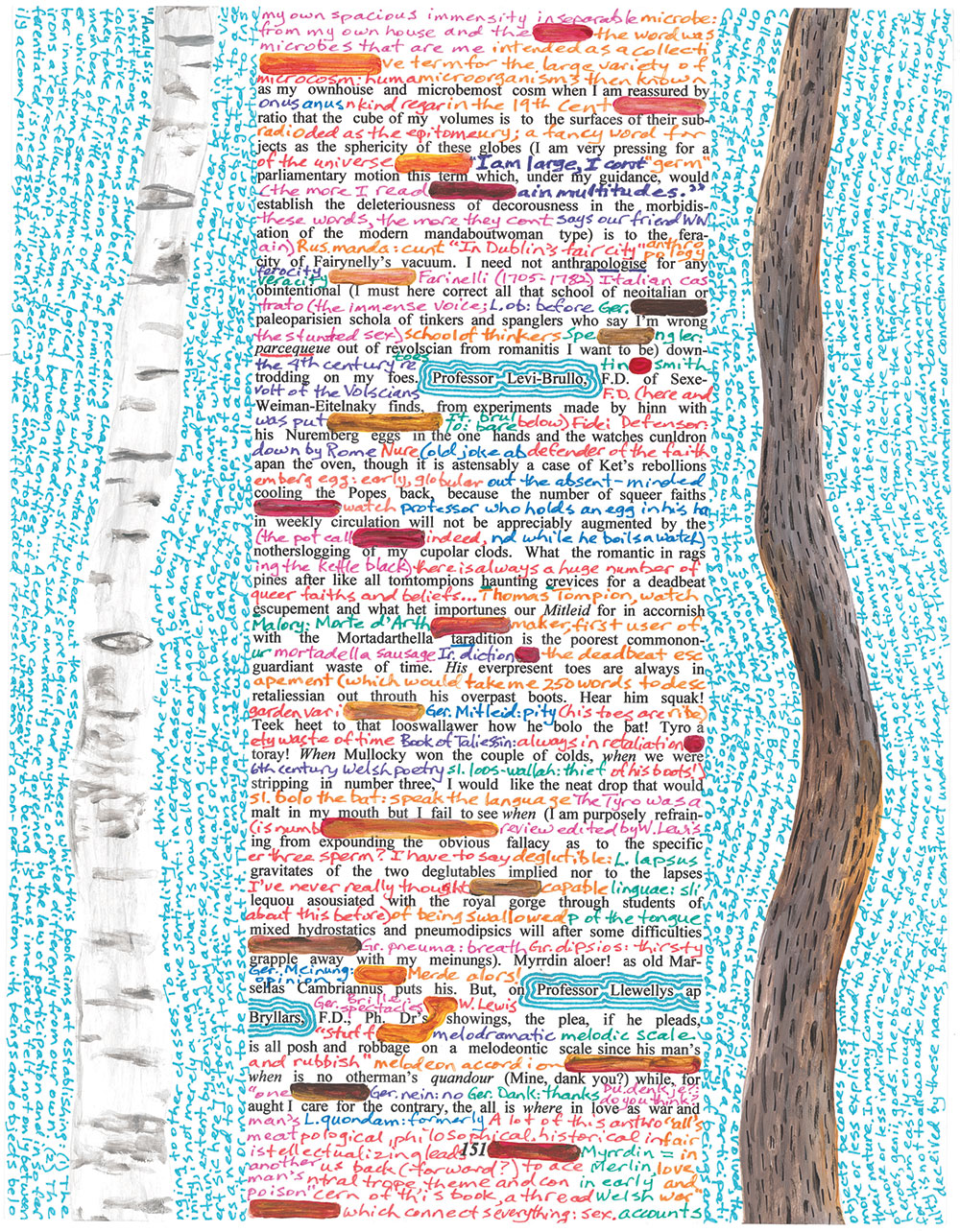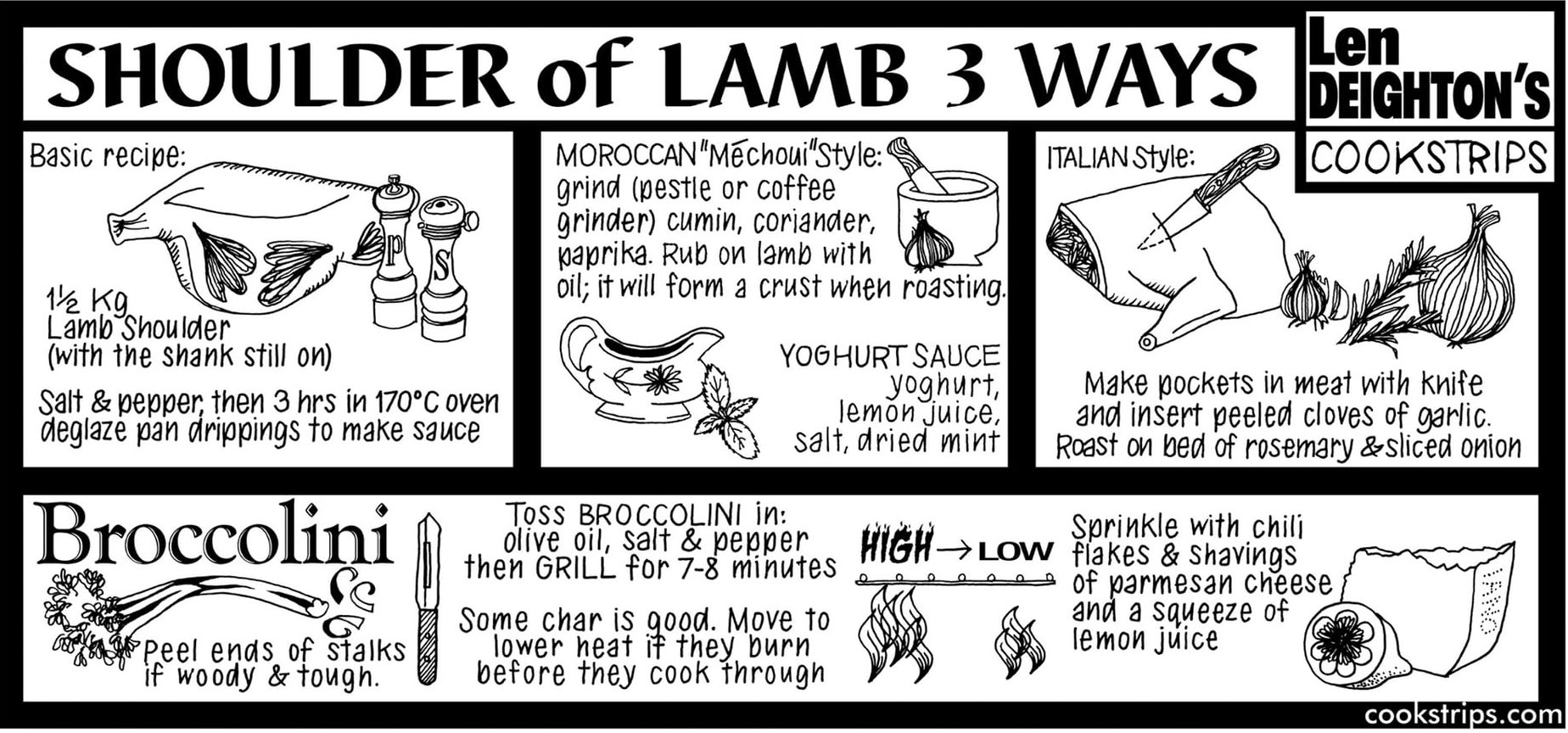I challenge you to think clearly about the many disparate networks you’re part of and think about the ideas you might want to offer those networks that you don’t want to get lost in the feed. Ideas you might want to return to.
Tag: writing
Lots of Fun With Finnegan’s Wake
Peter O’Brien is currently illustrating the 628 pages of Finnegans Wake by James Joyce. Here’s a page from an article in the Globe and Mail:
Joyce used grist for Finnegans Wake from wherever he found it: the Bible, drinking songs, the morning paper. I likewise use images from various sources. These two trees are side-by-side at the cottage of a friend, and I thought they would be appropriate on a page where Joyce invokes Lucien Lévy-Bruhl and his work in the growing fields of sociology and ethnology.

Visit Peter’s site for more sample pages and links to other articles about the project, Lots of Fun With Finnegan’s Wake. He hopes to be finished by 2022.

Cookstrips by Len Deighton. I remember reading his spy novels as a kid, had no idea about his history as an illustrator and food persona.
I used to write regularly when I was younger. I kept journals, took classes, wrote online and for a newspaper. At some point I stopped. I’m not entirely sure why. It may have been burnout. It may have been writer’s block. Ultimately, it boils down to fear — fear of criticism, fear of disappointment, fear of failure, and so on. I’d love to get everything right, but that’s impossible.
So, in an effort to get over fear, I’ll hit publish and get started.
You are a real artist
For all my creative friends who’ve struggled at times trying to achieve their dreams, an artice from Sara Benincasa, Real Artists Have Day Jobs.
Have you ever dreamt of being a real artist?
Have you ever wondered what it would be like to call yourself a real painter, or a real writer, or a real actress, or a real musician?
Have you ever described yourself as someone who does something amazing and magical and wonderful and life-affirming and then added “on the side”?
Well, you might not like what I have to say.
Because I have come here today to deliver the unfortunate truth that you are lying to yourself.
You are not going to become a real artist one day.
You are a real artist right now.
Go read the rest.
Therapist for screenwriters
Barry Michaels helps screenwriters get over writer’s block.
By far the most common problem afflicting the writers in Michels’s practice is procrastination, which he understands in terms of Jung’s Father archetype. “They procrastinate because they have no external authority figure demanding that they write,†he says. “Often I explain to the patient that there is an authority figure he’s answerable to, but it’s not human. It’s Time itself that’s passing inexorably. That’s why they call it Father Time. Every time you procrastinate or waste time, you’re defying this authority figure.†Procrastination, he says, is a “spurious form of immortality,†the ego’s way of claiming that it has all the time in the world; writing, by extension, is a kind of death.
One space after a period
Despite whatever you’ve been told in the past, you should only put one space after a period, not two.
Is this arbitrary? Sure it is. But so are a lot of our conventions for writing. It’s arbitrary that we write shop instead of shoppe, or phone instead of fone, or that we use ! to emphasize a sentence rather than %. We adopted these standards because practitioners of publishing—writers, editors, typographers, and others—settled on them after decades of experience. Among their rules was that we should use one space after a period instead of two—so that’s how we should do it.
In my high-school typing class, we were working on ancient ICON computers which used monospace type, and were told to leave two spaces after a period for readability. I then spent years developing muscle-memory that had me double-tapping the spacebar after every full-stop. In university, I started writing for one of the newspapers and got yelled at for putting in double spaces and messing up the copy-setting — I learned quick. Fast-forward to book design, and given any sort of manuscript, getting rid of the double spaces is one of the first priorities. Remember, just one space.
Rushdie’s digital archives
During the past thirty years, writers have shifted from typewriters or pen and paper to word processors, adding a new layer of complexity to the tradition of archiving their work. Emory obtained Salman Rushdie’s archives, including notebooks, photographs, manuscripts, and a number of old computers. In The Author’s Desktop, Emory Magazine details the effort put into preserving his work for both academics and the general public. Rushdie’s archives were relatively easy to access, but others can prove much more difficult:
A particular challenge, she says, is that technology may have moved beyond the hardware or software artifacts in an author’s archive. For example, working parts may be difficult to find for a broken, early model computer, disks might be unable to be read, programs the author used might be outdated (think eight-track tapes without an eight-track tape player).
It’s not just hardware, software formats change too. The team had to do a lot of file conversions to make the documents available on modern systems. The files will probably need to be upgraded again and again. We could end up with the modern version of the transcription errors that occurred as scribes copied out manuscripts.
Using the long s
Andrew West examines the rules for long s:
It transpires that the rules are quite complicated, with various exceptions, and vary subtly from country to country as well as over time. I have summarized below my current understanding of the rules as used in roman and italic typography in various different countries.
Vitamin soup
An article from Richard Morgan about his experiences in seven years as a freelance writer.
Freelancing requires such strict adherence to toadyism, to sycophancy, to the grubbiest, lowliest submissions. It is an on-spec life and it is full of what can only be described as insane serendipity (or serendipitous insanity).
An interesting read if you’ve got any designs on being a freelance writer.
You’re your own boss now
Connor O’Brien takes a look at your day as a freelance writer.
Alright, now you’re out of bed. You’ll work two hours later to make up for the wasted time. Or maybe you’ll just work a little harder during the day. Yeah, that’s it. Don’t work longer, work smarter. You read that somewhere.
Or your day as pretty-much freelance anything. It’s all about motivation and self-control, which can easily go flying out the window.
Sledgehammer and whore
Sledgehammer and whore, a great story from a screenwriter named Josh, which details an unusual break-in at his office and how it could be pitched as a show.
